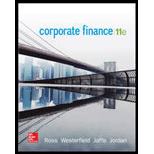
Case summary:
SP is a real estate firm that was established by the present CEO, RS, 25 years ago. The company had been profitable for the past 18 years. Before commencing the real estate business, RS was involved in a bankruptcy of a farming business. SP has a plan to buy a tract of land in U Country for $45 million. This land will be leased to tenant farmers. The land purchase will raise the annual pre-tax earnings by $10 million in perpetuity.
KM, the new CFO, has been put in charge of the current project. KM has determined that the firm’s cost of capital is 10.5%. KM feels that the firm should issue debts to finance the project. Based on some planning, KM thinks that the company can issue bonds at par value with a coupon rate of 7%; she also believes that the firm’s capital structure in the range of 70% equity and 30% would be optimistic. The firm has to bear 40% corporate tax rate.
To construct: SP’s market value
Want to see the full answer?
Check out a sample textbook solution
Chapter 16 Solutions
Corporate Finance (The Mcgraw-hill/Irwin Series in Finance, Insurance, and Real Estate)
- What is the duration of a four-year Treasury bond with a 10 percent semiannual coupon selling at par?arrow_forwardDon't used Ai solutionarrow_forwardYou bought a bond five years ago for $935 per bond. The bond is now selling for $980. It also paid $75 in interest per year, which you reinvested in the bond. Calculate the realized rate of return earned on this bond. I want to learn how to solve this on my financial calculator. Can you show me how to solve it through there.arrow_forward
- What are the Cases Not Readily Bound and what is a Dignity in a Research Study? What are the differences between Dignity in a Research Study and Cases Not Readily Bound? Please help to give examples.arrow_forwardWhat are the Case Study Research Design Components. Please help to give examplesWhat are the Case Study Design Tests and Tactics and how would they do?arrow_forwardDescribe some different types of ratios and how they are used to assess performance. Explain the components of the formula and the order of operations to calculate them. Discuss what these ratios say about the financial health of the organization. Determine why it is sometimes misleading to compare a company's financial ratios with those of other firms that operate within the same industry.arrow_forward
- Is there retained earning statement an important financial statement at the income statement and or the cash flows statement?arrow_forward2-13. (Term structure of interest rates) You want to invest your savings of $20,000 in government securities for the next 2 years. Currently, you can invest either in a secu- rity that pays interest of 8% per year for the next 2 years or in a security that matures in 1 year but pays only 6% interest. If you make the latter choice, you would then reinvest your savings at the end of the first year for another year. Why might you choose to make the investment in the 1-year security that pays an interest rate of only 6%, as opposed to investing in the 2-year security pay- ing 8%? Provide numerical support for your answer. Which theory of term structure have you supported in your answer? 2-14. (Yield curve) If yields on Treasury securities were currently as follows: TERM YIELD 6 months 1.0% 1 year 1.7% 2 years 2.1% 3 years 2.4% 4 years 2.7% 5 years 2.9% 10 years 3.5% 15 years 3.9% 20 years 4.0% 30 years 4.1% a. Plot the yield curve. b. Explain this yield curve using the unbiased…arrow_forwardWhat is the holistic case study format, could you please provide an example?arrow_forward
- Description Discuss in detail the Goal(s) of the firm. Additionally, List and discuss the 5 principles that form the foundations of finance. Lastly, List and discuss the various legal forms of business organizations.arrow_forwardWhat is the purpose of a case studty? Why is it important for researchers? Please give the examplesarrow_forwardInvestors in corporate zero-coupon bonds include all of the following EXCEPT: A: Tax-exempt retirement plans B: Conservative investors who want to lock-in their returns C: Investors who are saving for their children's college education D: Investors who do not need current cash flows E: All of the above are potential zero-coupon investorsarrow_forward
 Financial Accounting: The Impact on Decision Make...AccountingISBN:9781305654174Author:Gary A. Porter, Curtis L. NortonPublisher:Cengage Learning
Financial Accounting: The Impact on Decision Make...AccountingISBN:9781305654174Author:Gary A. Porter, Curtis L. NortonPublisher:Cengage Learning Intermediate Financial Management (MindTap Course...FinanceISBN:9781337395083Author:Eugene F. Brigham, Phillip R. DavesPublisher:Cengage Learning
Intermediate Financial Management (MindTap Course...FinanceISBN:9781337395083Author:Eugene F. Brigham, Phillip R. DavesPublisher:Cengage Learning





